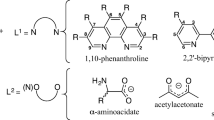Abstract
MESQUAC (Mixed ElectroStatic QUAntum Chemical) calculations have been performed for the aquocomplex of the Ti(III) ion. First, second and third hydration spheres have been taken into account, leading to excellent agreement with the experimental solvation energy of this ion in water. The calculations indicate, that two hydration spheres are bound tightly to the ion, whereas for the third sphere no more strong ordering should be expected. Methodical details as the choice of fractional point charges and the number of ligands included in the full quantum chemical description have been varied to test the method's reliability for calculations on transition metal complexes. Besides thermodynamic quantities also the absorption spectrum of aqueous Ti(III)-solutions has been taken as a basis for testing the results of the calculations. By a slight extension of the original MESQUAC concept also spectroscopic properties are obtained rather satisfactorily. Exponents of optimized smallGaussian basis sets for the transition metals Ti to Zn are given, which seem to be suitable for the use in such calculations.
Similar content being viewed by others
Literatur
B. M. Rode undG. J. Reibnegger, J. Chem. Soc. Faraday II,75, 178 (1979).
B. M. Rode undR. Fussenegger, Mh. Chem.108, 703 (1977).
W. Kutzelnigg, Angew. Chem.85, 551 (1973).
B. M. Rode, Mh. Chem.106, 339 (1975).
L. E. Sutton, Tables of Interatomic Distances. London: The Chemical Society. 1958.
P. Schuster, W. Jakubetz undW. Marius, Topics in Current Chemistry60, 1–107 (1975).
H. Kistenmacher, H. Popkie undH. Clementi, J. Chem. Phys.61, 799 (1974).
H. Montgomery, Acta Cryst.20, 731 (1966).
H. Ohtaki undM. Maeda, Bull. Chem. Soc. Japan47, 2197 (1974).
H. Ohtaki, T. Yamaguchi undM., Maeda, J. Chem. Soc. Japan49, 701 (1976).
J. O. Noell undK. Morokuma, Chem. Phys. Letters36, 465 (1975).
M. C. Day undJ. Selbin, Theoretical Inorganic Chemistry. New York: Reinhold Publ. Co. 1965.
Author information
Authors and Affiliations
Additional information
Herrn Prof. Dr.O. E. Polansky zum 60. Geburtstag gewidmet.
Rights and permissions
About this article
Cite this article
Rode, B.M., Reibnegger, G.J. Zur Anwendbarkeit des MESQUAC-MO-Verfahrens auf Übergangsmetallkomplexe. Monatshefte für Chemie 110, 813–822 (1979). https://doi.org/10.1007/BF00906675
Received:
Accepted:
Published:
Issue Date:
DOI: https://doi.org/10.1007/BF00906675



